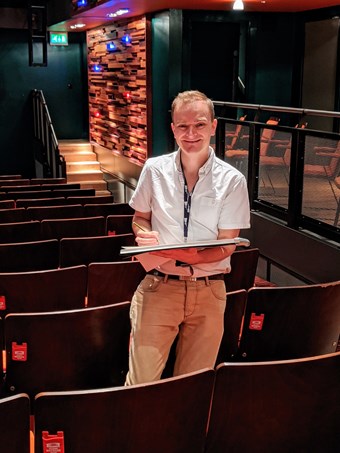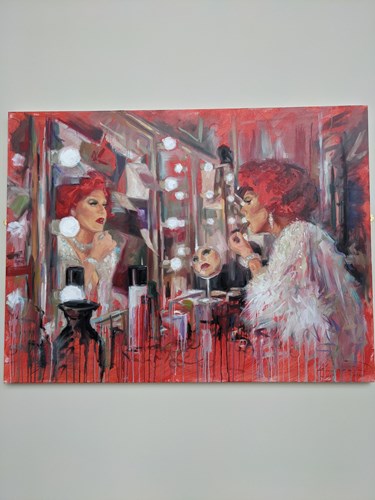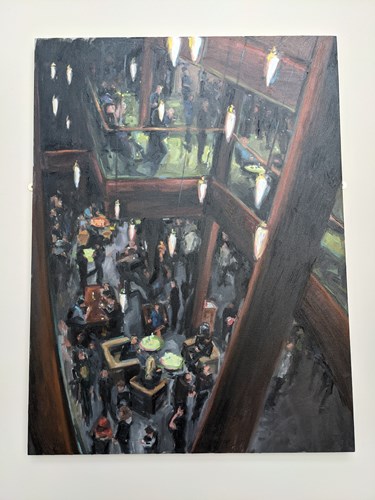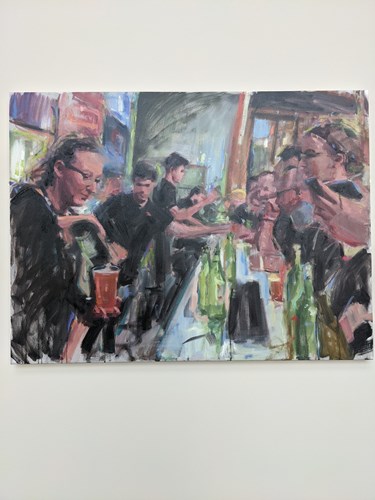Artist in Residence Exhibition
Aylesbury Waterside Theatre embarked on their first Artist in Residency with painter Peter Keegan late in 2019. The partnership was intended to celebrate their 10th birthday year with Peter capturing iconic moments and exclusive backstage scenes rarely seen by the public eye.
By twist of fate and uncanny timing, Peter has now by default poignantly captured the theatre industry pre and post-pandemic. His artistry has reflected an era in the industry never to be experienced before. The last few months before Covid-19 were thriving - sold out pantomime performances, buzzing backstage corridors, packed bars and a programme full of productions and events. Peter painted the last standing concert, 48 hours before the Government’s closure announcement in March 2020. He revisited the venue during its period of closure, when only a single staff member was working in venue maintaining the sleeping building.
We are delighted to say Peter is committed to continuing to tell our story as we revamp, relaunch and reopen our doors once more. We hope you enjoy his work and learning more about our fascinating industry.

And a Bra that was Made to Fit three
Oil on canvas
By Peter Keegan
Andy Collins regularly stars as the comic in the Waterside’s annual pantomime. His character is full of fun, slapstick and a trademark charm that makes him a favourite with children and adults alike. The painting depicts Andy’s much loved routine ‘The 12 Days of Christmas’, holding his famous pots and pans and the bra that was made to fit three. Andy and two fellow cast members rush around the stage in a complete frenzy trying to sing the song with props in tow – and the outcome is always one of sheer mayhem with audience participation aplenty.
On painting this portrait, Peter said “I wanted to capture a sense of the bright colours of the dazzling costumes synonymous with Pantomime, shining brightly under the intense stage spotlight. I also wanted to capture the feeling that Andy has a strong connection with the audience; him grinning at the families who are hanging on his every word.”
Pantomime has a long theatrical history in Western culture dating back to classical theatre. It developed partly from the 16th century commedia dell'arte tradition of Italy and other European and British stage traditions, such as 17th-century masques and music hall. Today, Pantomime for regional theatre is huge in terms of the revenue it brings into the venue and also for community engagement. Over 40,000 theatregoers enjoy the family production at Aylesbury Waterside yearly, and it is testament to the genre that it continues to appeal to all ages. The successful formula of songs, dancing, comedy and slapstick alongside topical humour all wrapped up in a well-known fairy tale, fable or folk tale has stood the test of time.


Quick Change
Oil on canvas
By Peter Keegan
Many shows rely on the rapid skills of the wardrobe department to ensure costume changes are made swiftly and with precision. Here Amelia Adams is playing Belle in Beauty & the Beast and has to change from her character’s day clothes into the iconic golden ball gown ready for supper with the beast. Her two dressers (one with a head torch to ensure fastenings can be easily seen and quickly secured) only had 30 seconds to make the quick change.
Peter said “When observing the actors backstage, I was amazed to see how many were just as busy whilst backstage as they were when onstage. Everything from prop adjustments, timing stage entries or costume changes; there was always something going on back there. For me, the quick change was the most impressive of these moments; unseen by the public, but so beautifully rehearsed and astonishingly well-coordinated between actor and dresser.”
The wardrobe department is key to every production. They ensure costumes are safely transported between venues and carry out regular alterations and repairs after performances (and sometimes even during, if a button has popped off or an accidental tear appears!) To date, the most costume-heavy production at the Waterside has been Priscilla Queen of the Desert. The costumes were flamboyant and bold with sequins and large feathered headdresses. For this production, clothing rails lined the backstage corridors as there simply wasn’t enough space in the dressing rooms alone.
The Dressing Room
Oil on canvas
By Peter Keegan
Here La Voix is applying the finishing touches to her make-up before her one-woman show. Dressing Rooms with mirrors surrounded by bright light bulbs are synonymous with backstage theatre. They are often found full of flowers and cards from fans and well-wishers alongside make up brushes, hair products, personal possessions and show costumes.
For Peter ‘the dressing room appeared to be a sanctuary for the performers compared to the busy, public arena of the stage. It was where the actors could relax, think, get into their role and have that private moment to themselves before performing to their audience’.
Aylesbury Waterside has 11 dressing rooms in total of varying sizes to cater for solo artists and larger ensembles. Dressing rooms are fitted out with fridges and some have showers and other facilities to make the home-from-home experience an enjoyable one for visiting companies. They have a tannoy system which links them to the Stage Manager who delivers ‘calls’ from the stage alerting cast as to how long they have before the show starts. The ‘beginners’ call’ is 5 mins before the ticketed start time to allow performers ample time to get to the wings (side of stage) before the curtain rises.


Tech Get In
Oil on canvas
By Peter Keegan
The technical team are the stars behind-the-scenes, often found in the shadows backstage rather than the limelight out front, ensuring scene changes go smoothly and productions run safely. In this painting, the backstage crew, (who always wear black clothing to ensure they’re as inconspicuous as possible when shows are taking place), were watching set being constructed and learning how it worked, ready to operate during the show.
Peter recalls, “I was so surprised to see just how many backstage crew it takes to support a large-scale production such as a pantomime, musical or opera. In some cases there were more backstage crew than there were on-stage performers. I enjoyed observing these mysterious backstage workers in their dark, natural habitat and wanted to capture them as a group, putting them in the spotlight for a change."
Team Work is key for ‘get ins’ – which as the term suggests is simply productions ‘getting in’. They often involve moving heavy flight cases, bulky scenery, large props and hefty backcloths making sure they are secured safely ready for use during the show. Communication is key, with every technician on radio to hear cues.
Fly Floor
Oil on canvas
By Peter Keegan
The fly floor at Aylesbury Waterside Theatre is home to 56 individual counterweighted ropes, or lines, attached to a corresponding bar in the grid above our stage, each capable of hoisting or lowering up to 500kg of weight. This is where scenery, backcloths and pieces of set are ‘flown’ in and out at lightning speed, allowing scene changes to happen in the blink of an eye. It is a very physical, high pressure role in live theatre, requiring extreme precision. Radio communication is essential in ensuring cloths are flown safely, without potentially injuring the cast or stage crew below. This painting shows Dan and Jim (Head Flyman) executing a cue.
Peter said of this operation: “The thing that impressed me most about the Flymen was their synchronisation in raising or lowering such huge weights. Their movement was akin to the movement of dancers; just as choreographed and rehearsed. In this painting I wanted to capture that moment, just before their call was made to raise the next backdrop amongst the complex network of 56 ropes.”


Health and Safety
Oil on canvas
By Peter Keegan
Being a Flyman is a role of enormous responsibility. Not only is the act of flying large, heavy objects, at speed and in the dark a high-stakes task in itself, but having a birds-eye-view of complex scene changes happening on the ground is absolutely invaluable to the stage crew. Communication and vigilance are an essential part of Health and Safety protocols at the Waterside.
A historical theatre rule is to never whistle while in the wings or close to stage. This is because in the past, flymen were often sailors on shore leave who were used to whistling to each other as a method of communication. A misplaced whistle would likely result in a cue being triggered early and a piece of scenery ending up on someone’s head!
Front of House
Oil on canvas
By Peter Keegan
Front of House, the name given to the main entrance of a theatre, welcomes hundreds of customers daily and is the perfect meeting place pre-show. The Waterside’s 3 floors of spacious foyers are ideal for visitors to meet and enjoy refreshments. The foyer is beautifully lit by 432 hand-blown glass pendant lights representing raindrops falling through the Chiltern Hills and over 100,000 hand-placed blocks of timber decorate the foyer areas and auditorium.
Peter explains: “One of the things I wanted to try and capture was the impressive contemporary architecture that greets visitors, designed by architect Norman Bragg. I love the way the theatre is made up of many natural materials such as slate and wood and how Bragg’s strong, structural, linear design across the building is softened by the rain-drop lights speckled throughout, giving the theatre a wonderful sense of space and depth.”
The Front of House team includes Duty Managers, ushers, bar and kiosk staff, all committed to delivering the best customer experience possible.


Bar Life
Oil on canvas
By Peter Keegan
Bars are at their busiest during gig nights – and the one depicted here was no exception. Poignantly, it was the last standing concert with singer/songwriter Frank Turner in March 2020 - in fact it was the last event before the theatre closed for 16 months in line with Government guidelines. The painting demonstrates the demand for refreshments and also the speed at which staff have to serve!
Drinks are sold alongside other theatre favourites including ice cream, popcorn and flashing wands during children’s shows. On average (over a 5 year period) the venue sells close to 50k bags of sweet, nearly 20k flashing wands and over 200k ice creams.
Theatre in isolation
Oil on canvas
By Peter Keegan
Throughout the theatre’s period of closure (from 16 March 2020 until September 2021) minimal staff were working at the venue. Indeed up until June 2021 only a single member of staff was visiting the venue 3 times a week to handle the general maintenance of the venue and carry out basic building checks. All stock had to be cleared from the building due to expiry dates being exceeded, and workstations from desks to bars and the Box Office were all left unoccupied during this unprecedented time.
Lou Stevens the venue’s designated lone worker, said of the experience:
“The hardest part for me, was seeing the building empty. I’m so used to The Waterside being a warm and vibrant place, full of life and activity. The stark, cold reality of being here alone, hearing the echoes as I moved round the building, really hit home for me. It was a period in time I’ll never forget. Here’s to the return of live entertainment, the ‘good-ship’ Waterside and all who sail in her.”
In this painting, Peter wanted to capture “the enormous scale of the beautiful auditorium alongside the overwhelming impact of the theatre being closed for such a long period of time. For me, nothing represented this better than having Lou, the lone worker at the theatre during the pandemic, stand alone in what should be a packed ‘full-house’ looking at a black, empty stage.”